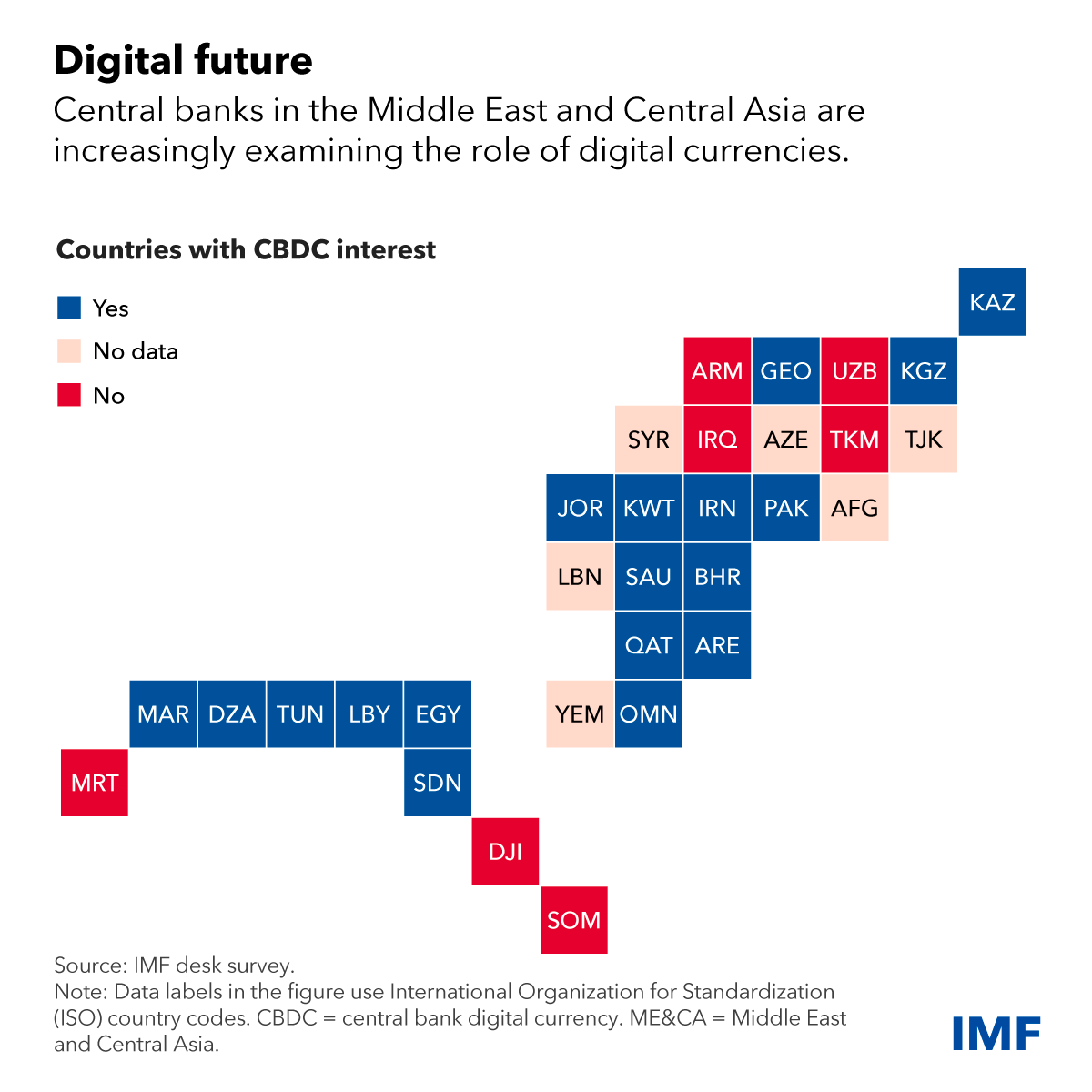Almost two-thirds of countries in the Middle East and Central Asia are exploring adopting a central bank digital currency as a way to promote financial inclusion and improve the efficiency of cross-border payments.
Adopting a CBDC, however, requires careful consideration. Countries across these regions, spanning a diverse group of economies stretching from Morocco and Egypt to Pakistan and Kazakhstan, each must weigh their own unique set of circumstances.
Many of the 19 countries currently exploring a CBDC are at the research stage. Bahrain, Georgia, Saudi Arabia, and the United Arab Emirates have moved to the more advanced “proof-of-concept” stage. Kazakhstan is the most advanced after two pilot programs for the digital tenge.
CBDCs can potentially help improve the efficiency of cross-border payment services. This appears to be an important priority for oil exporters and the Gulf Cooperation Council countries of Bahrain, Kuwait, Oman, Qatar, Saudi Arabia, and the United Arab Emirates. That’s because cross-border payments tend to have frictions like varying data formats and operating rules across regions and complex compliance checks. CBDCs that address these inefficiencies could significantly cut transaction costs.
Some countries have already introduced cross-border technology platforms to address these issues and promote digital currency payments between countries. One example is the Buna cross-border payment system, created by the Arab Monetary Fund in 2020.
CBDCs can advance financial inclusion by fostering competition in the payments market and allowing for transactions to be settled more directly and with less intermediation, in turn lowering the cost of financial services and making them more accessible. Unlike commercial banks, central banks can also help keep costs lower as they aren’t concerned with making a profit. Similarly, the resulting increased competition in the payments market from a CBDC could also encourage upgrading technology platforms and the efficiency of payment services, helping financial services reach more people. Countries in the Caucasus and Central Asia, Middle East and North Africa oil importers, and low-income countries are especially interested in this potential benefit.
However, without remedying some of the barriers to increased use of digital accounts and payments—low digital and financial literacy, lack of identification, distrust of financial institutions, and low wealth—CBDC uptake may only have marginal benefits.
Containing risks
Deposits make up a large share of bank funding in the region, about 83 percent. Because a CBDC may compete with bank deposits, it could weigh on bank profits and lending and have implications for financial stability. However, lenders in the region generally have adequate capital levels, profit margins, and liquidity buffers, and their relatively high concentration may limit strains on deposits. Large banks are especially dominant in Gulf Cooperation Council countries.
For monetary policy, CBDCs could strengthen the pass-through into deposit rates by increasing competition among banks. A CBDC could also strengthen the bank lending channel of monetary policy. However, as our paper underscores, the impact would likely be country-specific and is difficult to estimate because CBDC uptake is limited so far.
Policymakers can mitigate potential risks to financial stability. While there are no clear prerequisites to adopting CBDCs, a healthy banking system, a sound legal system, and strong supervisory and regulatory capacity are the most important for reducing risks. Design features to limit competition with bank deposits, such as using carefully calibrated restrictions on CBDC balances and transactions, could also help.
Design features are an important consideration. Our survey shows that selecting appropriate features for CBDC implementation is a key challenge for regional policymakers. Achieving the policy objectives of promoting financial inclusion and payment system efficiency will depend on relevant design choices. For instance, designing CBDCs to work offline could promote financial inclusion in areas with spotty mobile service, such as in low-income countries and fragile and conflict-affected states. Similarly, using CBDCs for cross-border transfers could help lower the cost of sending remittances and speed up transfer times.
Ultimately, introducing digital currencies will be a long and complicated process that central banks must approach with care. Policymakers need to determine if a CBDC serves their country’s objectives and whether the expected benefits outweigh the potential costs, risks for the financial system, and operational risks for the central bank. Moreover, adoption may not be essential to achieving the intended policy goals, and addressing underlying constraints could be a more practical alternative, such as adopting or improving other digital payment systems.
For its part, the IMF is helping countries explore CBDCs. Through capacity development and surveillance, we support policymakers evaluating the need to issue a CBDC and help them craft strong policies and regulatory frameworks that can minimize monetary and financial stability risks. The IMF also is publishing new chapters of our CBDC handbook, guided by specific country capacity development questions on evaluating the need and risks, and developing concrete plans to issue a CBDC.
—This blog is based on the recent departmental paper, Central Bank Digital Currencies in the Middle East and Central Asia. For more on regional approaches to CBDC, see this blog: More African Central Banks Are Exploring Digital Currencies.







